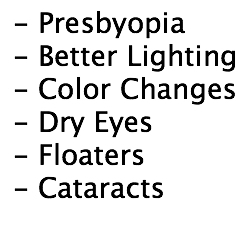 It starts out simply enough. One day, you hold the newspaper, magazine, book, or menu you’re reading a little farther away than you did before. Time marches on and a while later – after you’ve been slowly adjusting – you realize that you’ve run out of arm to hold your newspaper and that’s when it dawns on you: either your arms have gotten shorter or your eyes are starting to go.
It starts out simply enough. One day, you hold the newspaper, magazine, book, or menu you’re reading a little farther away than you did before. Time marches on and a while later – after you’ve been slowly adjusting – you realize that you’ve run out of arm to hold your newspaper and that’s when it dawns on you: either your arms have gotten shorter or your eyes are starting to go.
Welcome to middle age.
According to the AARP (American Association of Retired Persons), right around the age of 40, many adults begin to develop age-related eye conditions. The most noticeable one is called presbyopia (prez-bee-OH-pee-uh), a loss of near vision. This happens when the lens of the eye starts to stiffen, making it harder to see close objects. In addition to your vision changing, the National Institute on Aging says presbyopia can cause headaches or strained, tired eyes. A visit to an optometrist will help you to identify if just a pair of reading glasses or a bifocal or multi-focal prescription is necessary. All About Eyes has a wide variety of eyeglasses available to choose from.

In addition to presbyopia, some adults will begin to see a need for better lighting when they read. When the lens of the eye becomes less transparent, it makes it harder for light to pass through to the retina. The Merck Manual, a reference for doctors, says that adults ages 60 and above need three times more light to read than a 20-year-old.
Other issues that can affect aging eyes are changes in how color is perceived, due to the lens yellowing over time, making it harder to spot the difference between shades of the same color or similar colors. Dry eyes can also start to happen, where the fluid lubricating the eyeball begins to diminish. And then, there are the floaters. As we age, more floaters will begin to appear in our field of vision. The spots can look like clear or dark strings. You may notice them more when looking at the sky during daytime or other bright, plain surface. They are made up of bits of normal fluid that have solidified. And finally, cataracts may also develop as we age. Cataracts are a clouding of the lens in the eye which causes the vision to progressively get blurrier. They can be removed by surgery.
Regular check-ups with your optometrist can help to identify – and in many cases – correct all of these aging eye issues.

